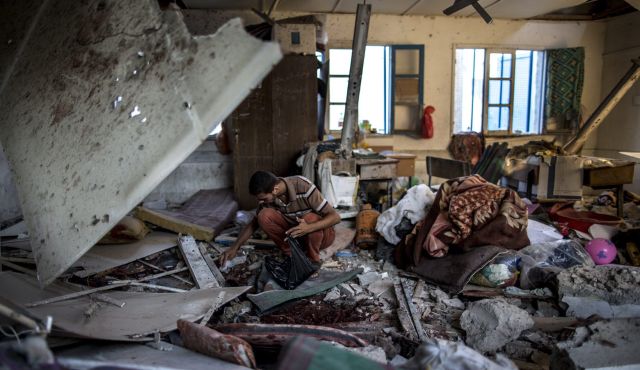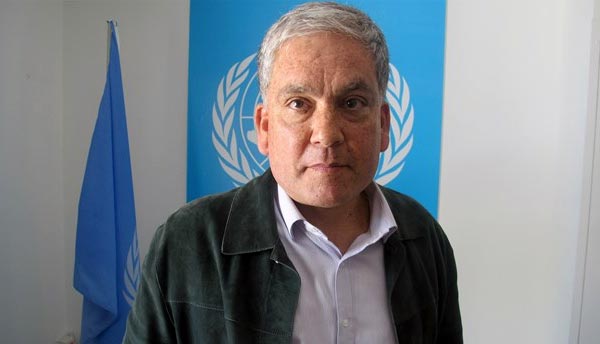Chris Gunness, spokesman for the United Nations Relief and Works Agency for Palestinian Refugees in the Near East (UNRWA), discusses the causes and consequences of the fact that only about 5% of pledged donations have reached Gaza.[This transcript has been lightly edited.]
Ken Klippenstein: What has been the impact of the failure of donor aid funds to reach Gaza?
Chris Gunness: Let me illustrate that with one simple vignette. I was in Gaza yesterday and I met a grandfather living in the northern area, which is near the fence with Israel. The man is 62. Two of his grandchildren froze to death (i.e., died of hypothermia) during the storm known as Huda, which was in January.
They are living, 15 of them, in a shack, which when I saw it from the road, I assumed that it was for animals. When I went there, it was a tiny, three-roomed wooden structure covered in leaky plastic. It was raining, so water was flowing in. And that is the very place where baby Salima died on the 21st of January at the age of just 40 days old.
The floor is sand, and on top of that they’ve put threadbare carpets which, when you sit on them, they’re so wet and cold [that] it’s no protection whatsoever. Baby Salima basically got rained on all night. There was nowhere for them to go. Her body was blue and trembled. They took her to the hospital and after one night, the doctor phoned up and said that Salima was dead. Another grandchild, a boy, was 50 days old. He was in a UN shelter; it was freezing cold and he died very suddenly of hypothermia.
There are about 110,000 homes which are either completely uninhabitable or very badly damaged. Assuming each home has between six and eight people, that’s 600,000-800,000 people, approximately. So both in terms of the depth of the suffering and the breadth of the humanitarian impact, it’s immense.
KK: Why haven’t the donor funds gone through? We heard so many different countries, from the Gulf states to the West, pledge aid – $5.4 billion, in fact.
CG: Your question is a very good one. Unfortunately, I don’t have the answer. It’s not from lack of appeals from us; it’s not from want of me telling stories like this; it’s not from lack of donors being given the figures, analysis, what the cost will be in human terms. All of this stuff they know, so there’s absolutely no shortage of information.
KK: What obligation does the West – particularly the United States, but also [Europe] – have to reconstruct Gaza, given that they are the ones who armed Israel? The West armed Israel with precisely the same weapons that were used to destroy Gaza in this last operation.
CG: And also, it’s those same donors who all met in Cairo [and agreed to rebuild Gaza] – without any security guarantees that it’s not going to be completely leveled again in another couple of years time, as has happened for the last 6 years. There have been three wars since 2009.
You should also ask what are the responsibilities of the belligerent parties, because in a conflict, the belligerent parties are responsible for the protection of civilians.
I think if you look at the Palestinian refugees in Gaza…we have a situation where Gaza is under blockade and the political pressures that need to come to bear to lift the blockade are not being effectively brought to bear. So the blockade continues.
Not only do huge swathes of Gaza look like an earthquake just hit, but it’s proven very difficult to reconstruct because the funds simply are not there.
What is the point of reconstructing Gaza if the place is not allowed to have a functioning economy? Do you want gleaming white, new houses and totally impoverished people because the population can’t export?
What you need in an economy like Gaza is to be able to import raw materials to make things [like] garments and export them. If you can’t export them then you can’t have a functioning economy. The people of Gaza are incredibly entrepreneurial. They’re very proud. They don’t want to suffer the indignities of aid dependency.
What are the obligations of the international community? One of their obligations is to put pressures to bear on the right place so that the blockade is lifted by Israel and the people of Gaza are allowed to trade. If you trade, you can have a disposable income; if you have a disposable income, you can buy things.
We don’t want to be going to the donor community with our begging bowl in hand and asking for money. It’s much better if people in Gaza can have their own economy. Of course they’ll need assistance reconstructing the place, but thereafter, they need to have a functioning economy. Otherwise they’re going to be condemned for decades more to this life support system known as international aid.
KK: Israel has necessitated this aid by its blockade since Gaza doesn’t have a viable economy?
CG: Yeah. In the year 2000, there were 80,000 people in UNRWA’s food distribution. 15 years later, it’s 10 times that – 800,000. A lot of that aid dependency is due to the fact that there’s a blockade and Gaza cannot trade.
Unemployment is 44%. Food insecurity is rising. 90% of the water in Gaza is undrinkable. That’s the impact of the blockade. It’s devastating.
KK: As a UN official, could you comment on what obligations Israel has [under international law] as the occupying force in the Palestinian territories?
CG: In the UN, Israel is an occupying power, and has obligations to provide services, housing, water, electricity; all the things which protected populations need to have in situations of occupation. It’s all very clearly stipulated in the 4th Geneva Convention.
KK: What has been the effect of the destruction of the supply tunnels running from Egypt to Gaza?
CG: Make no mistake, the destruction of the tunnels has devastated a lifeline to the people of Gaza. I have absolutely no doubt whatsoever about that. But the majority of the crossings into Gaza are through Israel.
The Rafah crossing – I’ve been through it – is a single road in one direction. A very narrow road, actually. And a very narrow single road in the other direction. It is not a crossing through which you would want to mount a major import/export or aid operation to 1.8 million people.
KK: How does the failure of the aid to reach Gaza now compare with previous instances?
CG: This is as bad as it’s ever been, I think. After the Cairo conference where the donor community pledged $5.4 billion, we created a plan for $720 million [in aid]. That was for essentially two things: rental properties for people whose houses had been destroyed, and for repair and reconstruction. That $720 million plan has a deficit of $585 million.
I’ve never known it to be this bad and I’ve been here for 9 years.
KK: I imagine failing to reconstruct Gaza represents a security risk.
CG: Having 1.8 million desperate, isolated, destitute people at any country’s doorstep – especially given the history, and given that there’s a fence around it and a blockade – how can that ever be considered to be in anybody’s interest – not just Israel, but all of us?
The Palestinian cause is a source of anger and frustration in many places, including across the Middle East. So it’s in nobody’s interest anywhere in the world to have Gaza in the state that it’s in.
Ken Klippenstein is a journalist based in the U.S. He can be reached on Twitter @kenklippenstein or email: kenneth.klippenstein@gmail.com


